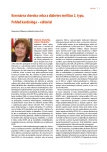Coronary artery disease and women
Authors:
Anna Vachulová 1; Martin Svetlošák 1; Andrea Vašková 2; Jozef Pacák 3; Branislav Vohnout 4; Ľuboš Urban 1; Slavomíra Filipová 5
Authors‘ workplace:
Oddelenie arytmií a kardiostimulácie, NÚSCH, a. s., Bratislava, primár prof. MUDr. Robert Hatala, CSc., FESC, FACC
1; Oddelenie gynekológie a pôrodníctva, FNsP J. A. Reimana, Prešov, prednosta MUDr. Jozef Adam, PhD.
2; Oddelenie intervenčnej kardiológie, NÚSCH, a. s., Bratislava, primár MUDr. Viliam Fridrich, PhD.
3; Diabetologická a lipidologická ambulancia – poruchy metabolizmu a výživy, Slovenská zdravotnícka univerzita, Bratislava
4; Klinika kardiológie a angiológie, LF SZU, NÚSCH, a. s., Bratislava, prednosta prof. MUDr. Róbert Hatala, CSc.
5
Published in:
Forum Diab 2015; 4(1): 33-39
Category:
Topic
Overview
Worldwide, cardiovascular disease is a major cause of mortality in women regarding to age, race, ethnicity, although the prevalence increases especially after menopause. Many factors contribute to the increased incidence of cardiovascular disease in women. Some of them are modifiable (obesity, smoking, dyslipoproteinaemia, hypertension, impaired glucose tolerance, diabetes mellitus). Some of them are underestimated. Women have a longer life expectancy than men. However, this trend of increased incidence of cardiovascular disease will deteriorate in consequence of growing epidemic of obesity, metabolic syndrome and diabetes, clinical states which mainly affect women. Atypical symptoms, old-age onset and higher prevalence of risk factors partly explain the higher incidence of complications and poorer prognosis of cardiovascular disease in women. Therefore, the efforts of doctors and healthcare professionals should lead to consistent recognition and treatment of risk factors of atherosclerosis and its complications.
Key words:
coronary artery disease – diagnostics of stable angina pectoris – risk factors of atherosclerosis – treatment of stable angina pectoris – women
Sources
1. Marco J, Chieffo A., Morice MC et al. Coronary Artery Disease in Women: scope of the problem. In: Marco J. Coronary Artery Disease in Women. Crossroads Institute: Diegem 2009: 9–20.
2. Mosca L, Grundy SM, Judelson D et al. Guide to Preventive Cardiology in Women. Circulation 1999; 99(18): 2480–2484.
3. Mosca L, Banka CL, Benjamin EJ et al. Evidence-based guidelines for cardiovascular disease prevention in women: 2007 update. J Am Coll Cardiol 2007; 49(11): 1230–1250.
4. Mosca L, Linfante AH, Benjamin EJ et al. National study of physician awareness and adherence to cardiovascular disease prevention guidelines. Circulation 2005; 111(4): 499–510.
5. Collins P, Rosano G, Casey C et al. Management of cardiovascular risk in the peri-menopausal women: a consensus statement of European cardiologists and gynaecologists. Eur Heart J 2007; 28(16): 2028- 2040.
6. Stramba-Badiale M. Women and research on cardiovascular diseases in Europe: a report from the European Heart Health Strategy (EuroHeart) projec. Eur Heart J 2010; 31:1677–1681. Dostupné z DOI: <http://dx.doi.org/10.1093/eurheartj/ehq094>.
7. Montalescot G, Sechtem U, Achenbach S et al. 2013 ESC guidelines on the management of stable coronary artery disease. The Task Force on the management of stable coronary artery disease of the European Society of Cardiology. Eur Heart J 2013; 34(38) 2949–3003.
8. Panico S, Mattiello A. Epidemiology of cardiovascular diseases in women in Europe. Nutr Metab Cardiovasc Dis 2010; 20(6): 379- 385.
9. Baráková A, Riečanský I. Epidemiológia srdcovocievnych chorôb. In: Riečanský I. Aterosklerotické choroby. Herba: Bratislava 2009: 19–116. ISBN 978–80–89171–64–4.
10. Hsia J. Managing carviovascular risk factors: Trial evidence in women. Nutr Metab Cardiovasc Dis 2010; 20(6): 445–50.
11. Sager H, Linsel- Nitschke P, Mayer B et al. Physicians´perception of guidelines recommended low- density lipoprotein target values: characteristics of misclassified patients. Eur Heart J 2010; 31(10): 1266–1273.
12. Yusuf S, Hawken S, Oounpuu S et al. Effect of modifiable risk factors associated with myocardial infarction in 52 counties (INTERHEART study): case control study. Lancet 2004; 364(9438): 937- 952.
13. Fox CS., Pencine MJ, Meigs JB et al. Trends in the incidence of Type 2 Diabetes mellitus from the 1970s to the 1990s: the Framingham Heart Study. Circulation 2006; 113(25): 2914–2918.
14. Assertheil-Smoller S, Shumaker S, Ockene J et al. Depression and cardio- vascular sequelae in postmenopausal women, the Women´s Health Initiative (WHI). Arch Intern Med 2004; 164(3): 289–298.
15. Anderson GL, Limacher M, Assaf AR et al. Women´s Health Initiative Steering Committee. Effects of conjugated equine estrogen in postmenopausal women with hysterectomy: the Women‘s Health Initiative randomized controlled trial. JAMA 2004; 291(14): 1701–1712.
16. Crilly MA, Bundered PE, Leckey LC et al. Gender bias in the clinical management of women with angina: another look at the Yentl syndrome. J Womens Health (Larchmt) 2008; 17(3): 331–342.
17. Collins SD, Ahmad S, Waksman R et al. Precutaneous revascularization in women with coronary artery disease: We´v come so far, yet have so far to go. Nutr Metab Cardiovasc Dis 2010; 20(6): 436–444
Labels
Diabetology Endocrinology Internal medicineArticle was published in
Forum Diabetologicum

2015 Issue 1
Most read in this issue
- The clinical diagnosis of stable coronary artery disease
- Importance of ambulatory blood pressure monitoring and ambulatory ECG monitoring in patients with coronary heart disease
- Coronary artery disease and women
- Cardio-metabolic risks of obesity
